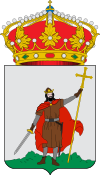Gijón
| Gijón / Xixón | |||
|---|---|---|---|
| — Municipality — | |||
|
|||
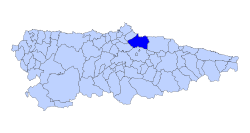 |
|||
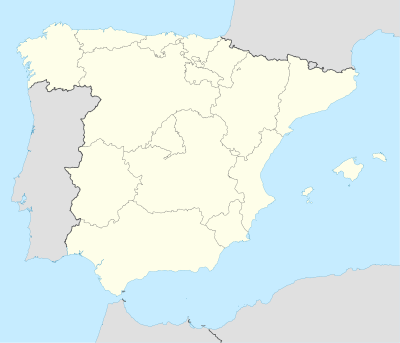 Gijón / Xixón
|
|||
| Coordinates: | |||
| Country | |||
| Autonomous community | |||
| Province | Asturias | ||
| Comarca | Gijón | ||
| Judicial district | Gijón | ||
| Founded | 5th century BC (Noega, the first settlement on record) | ||
| Government | |||
| - Alcalde | Paz Fernández Felgueroso (2007) (PSOE) | ||
| Area | |||
| - Total | 181.6 km2 (70.1 sq mi) | ||
| Elevation | 3 m (10 ft) | ||
| Highest elevation | 737 m (2,418 ft) | ||
| Lowest elevation | 0 m (0 ft) | ||
| Population (2008) | |||
| - Total | 275,699 | ||
| - Density | 1,518.2/km2 (3,932/sq mi) | ||
| Demonym | Castillian: Gijonés/sa Asturian: Xixonés/sa | ||
| Time zone | CET (UTC+1) | ||
| - Summer (DST) | CEST (UTC+2) | ||
| Postal code | 33201 -33212 | ||
| Official language(s) | |||
| Website | Official website | ||
Gijón (Spanish pronunciation: [xiˈxon]; Asturian: Xixón [ʃiˈʃon]), officially Gijón / Xixón,[1] is a coastal industrial city and a municipality in the autonomous community of Asturias in Spain. Early mediaeval texts mention it as "Gigia". It was an important regional Roman city, although the area has been settled since earliest history. The name was originally applied to a small peninsula presently referred to as Cimadevilla, literally "top of village," between two beaches, one of which has a recreational port today. The main port, one of the largest in the north of Spain, is called "El Musel". Gijón has a barely growing population of approximately 277,000 (2006).
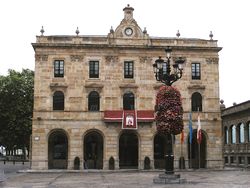
Contents |
Geography
The city is situated on the coast of central Asturias, from sea level to an altitude of 513 metres at Picu Samartín and 672 metres at Peña de los Cuatro Jueces, bordered on the West by Carreño, the East by Villaviciosa, and to the South by Siero and Llanera
The city is situated along the Asturian coast and is distinguished by the peninsula of Cimadevilla (the original settlement) which separates the beach of San Lorenzo and adjacent neighborhoods to the east from the beaches of Poniente and Arbeyal, the shipyards, and the recreational port and the Port of El Musel to the west. It is close to the other main Asturian cities, Oviedo and Avilés.
Districts
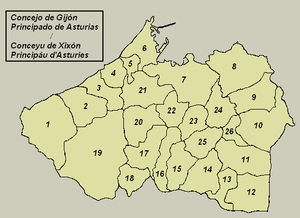
As a municipality, Gijón / Xixón is divided in 26 districts or parishes:
1. Serín 2. San Andrés de los Tacones 3. Fresno 4. Puao 5. Veriña 6. Jove / Xove 7. Gijón / Xixón 8. Somió 9. Cabueñes 10. Deva 11. Caldones 12. Valdornón 13. Fano 14. Llavandera 15. Samartín de Güerces 16. Leorio / Llorio 17. La Pedrera 18. Ruedes 19. L'Abadía Cenero 20. Porceyo 21. Tremañes 22. Roces 23. Granda 24. Castiello Bernueces 25. Vega 26. Santurio[2]
Gijón / Xixón city (numbered 7) is divided in four big areas (Centre, East, West and South) with several neighbourhoods within each one (Cimadevilla / Cimavilla, La Calzada, El Natahoyo, Pumarín, Viesques, El Llano, etc.)
Transport

The A-66 motorway (Ruta de La Plata), A-8 (Autopista del Cantábrico) and the AS-1 (Autovía Minera) are the main highway accesses. By train, Gijón has daily service to Madrid, Alicante, Zaragoza, and Barcelona. Cruise ships call at El Musel, and the Airport of Asturias is located in the not far away municipality of Castrillón with daily flights to major Spanish and European cities.
A subway system, called Metrotren, is currently under construction to improve the public transport in Gijón.
There are 22 regular lines of bus and 4 "night lines" of bus called "Buho" and special lines in special events like the Feria Internacional de Muestras de Gijon (Gijon International Exposition Fair) or the Semana Negra (literally Black Week)[2], the city's famous one-week Festival based on Hardboiled literature.
Climate
Gijón has an Atlantic humid maritime climate, with mild temperatures and high humidity throughout the year. The summers are warm, with both overcast and sunny days and winters are cold with significant rains.
| Climate data for Gijón | |||||||||||||
|---|---|---|---|---|---|---|---|---|---|---|---|---|---|
| Month | Jan | Feb | Mar | Apr | May | Jun | Jul | Aug | Sep | Oct | Nov | Dec | Year |
| Average high °C (°F) | 13.1 (55.6) |
13.8 (56.8) |
14.9 (58.8) |
15.6 (60.1) |
17.8 (64) |
20.2 (68.4) |
22.4 (72.3) |
23.2 (73.8) |
21.8 (71.2) |
19.0 (66.2) |
15.6 (60.1) |
14.0 (57.2) |
17.6 (63.7) |
| Daily mean °C (°F) | 8.9 (48) |
9.6 (49.3) |
10.7 (51.3) |
11.8 (53.2) |
14.3 (57.7) |
16.9 (62.4) |
19.2 (66.6) |
19.7 (67.5) |
17.9 (64.2) |
15.0 (59) |
11.6 (52.9) |
9.9 (49.8) |
13.8 (56.8) |
| Average low °C (°F) | 4.7 (40.5) |
5.4 (41.7) |
6.6 (43.9) |
8.1 (46.6) |
10.9 (51.6) |
13.6 (56.5) |
16.0 (60.8) |
16.2 (61.2) |
14.1 (57.4) |
11.0 (51.8) |
7.6 (45.7) |
5.8 (42.4) |
10.0 (50) |
| Precipitation mm (inches) | 94 (3.7) |
85 (3.35) |
74 (2.91) |
93 (3.66) |
79 (3.11) |
47 (1.85) |
45 (1.77) |
54 (2.13) |
70 (2.76) |
104 (4.09) |
120 (4.72) |
104 (4.09) |
971 (38.23) |
| Avg. precipitation days (≥ 1 mm) | 12 | 11 | 10 | 12 | 11 | 7 | 6 | 7 | 8 | 11 | 12 | 12 | 121 |
| Sunshine hours | 103 | 109 | 137 | 151 | 167 | 180 | 194 | 190 | 158 | 132 | 106 | 92 | 1,721 |
| Source: Agencia Estatal de Meteorología[3] | |||||||||||||
Culture
- During the early years of the 19th century the, then very small, town of Gijón was best known for its college or high-school known as the "Real Instituto Asturiano" founded by Jovellanos. [4]
- Gijón has a wide range of museum options. The Museo Internacional de la Gaita (International Bagpipe Museum) contains bagpipes from around the world, focusing on the Asturian musical heritage and bagpipes. There are also several other museums:
-
- Revillagigedo Palace and Museum (At Marqués square, near the City Hall)
- Nicanor Piñole Museum (An art museum)
- Evaristo Valle Museum (Local painter museum placed in a mansion at the outskirts)
- Museo del Ferrocarril (Railroad Museum, near Poniente Beach)
- Juan Barjola Museum (A museum about a local painter, also interested in avant-garde art)
- LABoralCentro de Arte y Creación Industrial (An exhibition centre for contemporary art, science, technology and advanced visual industries)
- The City Hall's sports and culture programs for citizens is wide, including the innovative Abierto Hasta el Amanecer (literally Open Till Dawn) nocturnal program, which tries to involve teens in cultural and sporting activities as an alternative to weekend nightlife.
- Gijon has 13 libraries in its Cultural City Centers, which feature a wide network of swimming pools and gyms.
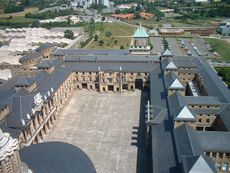

Sports
Gijón's professional soccer team, Sporting de Gijón, plays in the Spanish National League and is presently in the first division. American football and baseball are played in Gijón at top levels, with the Gijón Mariners and El Llano BC competing in the most important Spanish leagues of those sports.
Not far from Gijón, there are several ski resorts in Asturias, the main being Valgrande-Pajares.
Gijón has 13 public sport centers (in Spanish: Centros Municipales Integrados) with swimming pools, gyms and saunas. Swimming pools are free for children up to age 14.
The city's marina houses an important fleet of yachts and is the base for many water sports, being Royal Astur Yacht Club the most important yacht club in town.
Economy
For much of the twentieth century the town was heavily dependent on mature heavy industries, but at the end of the Franco era, tertiary sector employment began to expand rapidly along with the city's population which by 2007 stood officially at 277,897 for Gijón proper, and approximately 380,000 for the total Gijón agglomeration.
The port is at the centre of many of the local businesses. Apart from directly port related activities, the economy is based on tourism, steel (Arcelor), other metallurgy, livestock rearing and fisheries.
References
- ↑ Decreto 105/2006, de 20 de septiembre, por el que se determinan los topónimos oficiales del concejo de Gijón/Xixón.
- ↑ Decreto 105/2006, de 20 de septiembre, por el que se determinan los topónimos oficiales del concejo de Gijón/Xixón.
- ↑ "Valores Climatológicos Normales. Gijon". http://www.aemet.es/es/elclima/datosclimatologicos/valoresclimatologicos?l=1208&k=ast.
- ↑ (English) Name of the "Instituto Asturiano" and other details taken from the Universal Pronouncing Gazetteer By Thomas Baldwin, Sixth Edition, (1847). [1]
External links
- Gijon Municipality
- Official Touristic website of Gijón
- Non-official Website of Gijón Basket (professional basketball team)
- Official Toponyms - At City Council official website.
- Official Toponyms: Laws - BOPA Nº 229 - Martes, 3 de octubre de 2006 & DECRETO 105/2006, de 20 de septiembre (BOPA Errata corrections)
- Official site Sporting de Gijon
- LABoral Centro de Arte y Creación Industrial
|
|||||||

